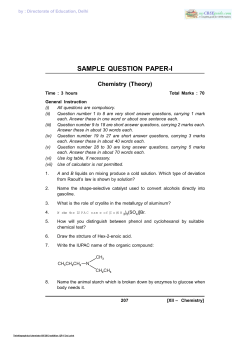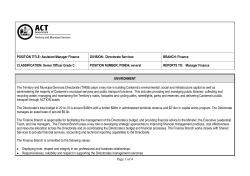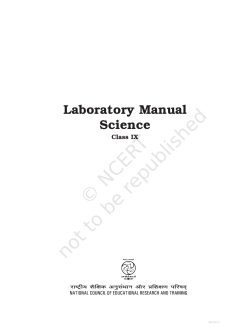
SAMPLE PAPER – II
by : Directorate of Education, Delhi SAMPLE PAPER – II Time Allowed : 3 hours Maximum Marks : 70 Note : Attempt All questions. Marks allotted to each question are indicated against it. 1. A magnet is is moving towards a coil with a uniform speed as shown in the figure. State the direction of the induced current in the resistor R. 1 2. A square coil, OPQR, of side a, carrying a current I, is placed in the Y-Z plane as shown here. Find the magnetic Moment associated with this coil. 1 3. Give one example each of a ‘system’ that uses the (i) Sky wave (ii) Space wave Mode of propagation [XII – Physics] 1 194 by : Directorate of Education, Delhi 4. A concave mirror, of aperture 4cm, has a point object placed on its principal axis at distance of 10cm fromthe mirror. The image, formed by the mirror,is not likely to be a sharp image. State the likely reason for the same. 1 5. Two dipoles, ade from charges + q and + Q, respectively, have equal dipole moments. Give the (i) retio between the ‘separations’ of the these two pairs of charges (ii) angle between the dipole axis of these two dipoles. 1 6. The graph, shown here, represents the V-I characteristics of a device. Identify the region, if any, over which this device has a negative resistance. 7. Define the term ‘Transducer’ for a communication system. 8. State the steady value of the reading of the ammeter in the circuit shown below. 1 9. The following table gives data about the single slit diffraction experiment: Wave length of Light Half Angular width of the Principal maxima p q 195 1 [XII – Physics] by : Directorate of Education, Delhi Find the ratio fo the widths of the slits used in the two cases. Would the ratio of the half angular widths of the first secondary maxima, in the two cases, be also equal to q? 2 10. N spherical droplets, each of raduis r, havebeen charged to have a potential V each. If all these droplets were to coalesce to form a single large drop, what would be the potential of this large drop? (It is given that the capacitance of a sphere of radius x equals 4 kx.) Two point charges, q1 and p2, are located at points (a, o, o) and (o, b, o) respectively. Find the electric field, due to both these charges, at the point, (o, o, c). 2 11. When a given photosensitive material is irradiated with light of frequency , the maximum speed of the emitted photoelectrons equals max. the square of max, i.e., max2, is observed to vary with , as per the graph shown here. Obtain express (i) Planck’s constant, and (ii) The work function of the given Photosensitive material, In terms of the aprameters, n and the mass, m, of the electron. 12. For the circuit shown here ,would the balancing length increase, decrease or remain the same, it 2 (i) R1 is decreased (ii) R2 is increased [XII – Physics] 196 by : Directorate of Education, Delhi without any other change, (in each case) in the rest of the circuit. Justify your answers in each case. 13. Find the P.E. assocaited with a charge ‘q’ if it were present at the point P with respect to the ‘set-up’ of two charged spheres, arranged as shown. Here O is the mid-point of the line 0102. 2 14. An athlete peddles a stationary tricycle whose pedals are attached to a coil having 100 turns each of area 0.1.m2. The coil, lying in the X-Y plane, is rotated in this plane, at the rate of 50 rpm, about the 6-axix,in a region where a uniform magentic field, B = (0.01) k tesla, is present. Find the (i) Maximum (ii) average e.m.f. Generated in the coil over one complete revolution. 2 15. A monochromatic source emitting light of wave length, 600 nm, has a power output of 66W. Calculate the number of photons emitted by this source in 2 minutes. 2 16. For the circuit shown here find the current flowing through the 1 resistor. Assume that the two diodes, D1 and D2, are ideal diodes. 197 [XII – Physics] by : Directorate of Education, Delhi 17. The galvanometer, in each of the two given circuits, does not show any deflection. Find the ratio of the resistors R1 and R2 used in these two circuits. 3 18. The election, in a hydrogen atom, initially in state of quantum number n1 makes a transition to a state whose excitation energy, with respect to the ground state, is 10.2 eV. If the wavelength, associated with the photon emitted in this transition,is 487.5 mm, find the 19. (i) energy in ev, and (ii) Value of the quantum number, n1 of the electron in its initial state. 3 Three identical polaroid sheets P1, P2, and P3 are oriented so that the (pass) axis of P2 and P3 are inclined at angles of 600 and 900, respectively, with respect to the (pass) axis of P1. A monochromatic source, S, of intensity I0, is kept in front of the polaroid sheet P1. Find the intensity ofthis light, as observed by observers O1, O2, and O3, postitioned as shown below. [XII – Physics] 198 by : Directorate of Education, Delhi 20. A fine pencil of -particles, moving with aa speed ,enteres region (region I), where a uniform electric and a uniform magnetic field are both present. These -particles then mvoe into region II where only the magnetic field, (out of the two fields present in region I), exists. The path of the particles, in the two regions, is as shown in the figure. (i) State the direction of the magnectic field. (ii) State the relation between ‘E’ and ‘B’ in region I. (iii) Drive the expression for the radius of the circular path of the particles in region II. If the magnitude of magnetic field,in region II, is changed to n times its earlier value, (without changing the magnetic field in region I) find the factory by which the radius of this circular path would change. 3. 21. Draw an appropriate ray diagram to show the passage of a ‘white ray’, indicent on one of the two refracting of a prism. State the relation for the angle of deviation, for a prism of small refracting angle. it is known that the refractive index, , of the material of a prism, depends on the wavelength, , of the incident radiation as per the relation. μ= A + 199 B λ2 [XII – Physics] by : Directorate of Education, Delhi where A and B constants. Plot a graph showing the dependence of on and identify the pair of variable, that can be used here, to get a straight line graph.3 22. Define the terms (i) mass defect (ii) binding energy for a nucleus and state the relation between the two. For a given nuclear reaction the B.E./nucleon of the product nucleus/ nuclei is more than that for the original nucleus/nuclei. Is this nuclear reaction exothermic or endothermic in nature? Justify your choice. OR (a) The number of nuclei, of a given radioactive nucleus, at times t=0 and t=T, are N0 and (N0/n) respectively. Obtain an expression for the half (T½) of this nucleus in terms of n and T. (b) Identify the nature of the’ radioactive radiations’, emitted in each step of the ‘decay chain’ given below: 3 A Z 23. X A4 Z2 Y A4 Z2 Y A4 Z 1 W Draw the waveforms for The (i) Input AM wave at A, (ii) output, B, of the rectifier and (iii) output signal, C, of the envelope detector. 24. The capacitors C1, and C2, having plates of area A each, connected in series, as shown. Campare the capacitance of this combination with the capacitor C3, again having plates of area A each, made up’ as shown in the figure. 3 [XII – Physics] 200 by : Directorate of Education, Delhi 25. (a) Write the formula for the velocity of light in a material medium of relative permittivityr and relative magnetic permeability. r. 1 (b) The following table gives the wavelength range of some constitution of the electromagnetic spectrum. S. No. Wavelength Range 1. 1mm to 700nm 2. 0.1m to 1mm 3. 400 nm to 1nm 4. < 10–3 nm Select the wavelength range, and name the (associated) electromagnetic waves, that are used in 26. (i) Radar systems for Aircraft navigation (ii) Earth satellites to observe growth of crops. 2 Suhasini’s uncle, was advised by his doctor to have an MRI scan of his chest. Her uncle did not much about the details and significance of this test. He also felt that it was too expensive and thought of postponing it. When suhasini learnt about her uncle’s problem, she immediately decided to do something about it. She took the help of her family, friends and neighbors and arranged for the cost of the test. She also toldher uncle that an MRI (Magnetic Resonance Imaging) scan of his chest would enable the doctors to know of the condition of his heart and lungs without causing any (test related) harm to him. This test was expensive 201 [XII – Physics] by : Directorate of Education, Delhi because of its set up that needed strong magnetic fields (0.5T to 3T) and pulses of radio wave energy. Her uncle was convinced and had the required MRI scan of his chesdt done. The resulting information greatly helped his doctors to treat him well. 27. (a) What according to you, are the values displayed by Suhasini and her (2) family, friends and neighbours to help her uncle? (b) Assuming that the MRI scan of her uncle’s chest was\ done by using a magnetic field of 1.0 T, find the maximum and minimum values of force that this magnetic field could exert on a proton (charge = 1.6 × 10–19) that was moving with a speed of 104 m/s. State the condition under which the force has its minimum value. 2 A conducting rod XY slides freely on two parallel rails, A and B, with a uniform velocity ‘V’. A galvanometer ‘G’ is connected, as shown in the figure and the closed circuit has a total resistance ‘R’. A uniform magnetic field, prependicular to the plane defined by the rails A and B and the rod XY (which are mutually perpendicular), is present over the region, as shown. (a) (b) With key k open: (i) Find the nature of charges developed at the ends of the rod XY. (ii) Why do the electrons, in the rod XY, (finally) experience no net force even through the magnetic force is acting on them due to the motion of the rod? How much power needs to be delivered, (by an external agency), to keep the rod moving at its uniform speed when key k is (i) closed (ii) open? [XII – Physics] 202 by : Directorate of Education, Delhi (c) With key k closed, how much power get dissipated as heat in the circuit? State the source of this power. OR Box’ A, in the set up shown below, represents an electirc device often usd/needed to supply, electric power from the (ac) mains, to a load. It is know n that V ° 28. <Vi. (a) Identify the device A and draw its symbol. (b) Draw a schematic diagram of this electric device. Explain its principle and working. Obtain an expression for the ration between its output and input voltages. (c) Find the relation between the input and output current of this device assuming it to be ideal. 5 Define the terms ‘depletion’ layer’ and ‘barrier potential’ for a P-N juction diode. How does an increase in the doping concentration afect the width of the depletion region? Draw the circuit of a full wave rectifier. Explain its working. OR Why is the base region of a transistor kept thin and lightly doped? Draw the circuit diagram of the ‘set-up’ used to study the characteristics of a npn transistor in its common emitter configuration. Sketch the typical (i) Input characteristics and (ii) Output characteristics for this transistor configuration. How can the output characteristics be used to calculate the ‘Current gain’ of the transistor? 203 [XII – Physics] by : Directorate of Education, Delhi 29. (i) A thin lens, having two surfaces of radii of cruvature r1 and r2 made from a material of refractive index 2, is kept in a medium of refractive index 1. Derive the Lens Maker’s formula for this ‘set-up’ (ii) A convex lens is placed over a plane mirror. A pin in now positioned so that there is no paralax between the pin and its image formed by this lens-mirror combination. How can this observation be used to find the focal length of the covnex lens? Give appropriate reasons in support of your answer. OR The figure, drawn here, shows a modified Young’s double slit experimental set up. If SS2–SS1, = /4, (i) State the condition for constructive and destructive interference (ii) obtain an expression for the fringe width. (iii) locate the position of the central fringe. 5
© Copyright 2025





















